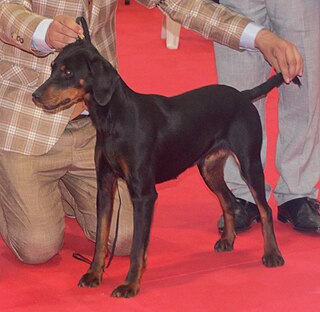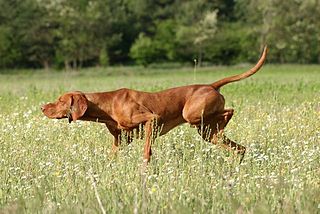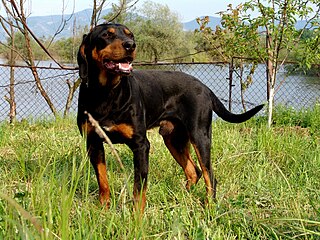This article relies largely or entirely on a single source .(November 2021) |
This is a list of recognized Hungarian dog breeds. [1]
This article relies largely or entirely on a single source .(November 2021) |
This is a list of recognized Hungarian dog breeds. [1]

A hound is a type of hunting dog used by hunters to track or chase prey.

Scent hounds are a type of hound that primarily hunts by scent rather than sight. These breeds are hunting dogs and are generally regarded as having some of the most sensitive noses among dogs. Scent hounds specialize in following scent or smells. Most of them tend to have long, drooping ears and large nasal cavities to enhance smell sensitivity. They need to have relatively high endurance to be able to keep track of scent over long distances and rough terrain. It is believed that they were first bred by the Celts by crossbreeding mastiff-type dogs with sighthounds. The first established scent hounds were St. Hubert Hounds bred by monks in Belgium during the Middle Ages.

The Montenegrin Mountain Hound is a rare dog breed originating from the mountainous regions of Montenegro. Black and tan, with a smooth coat, the Montenegrin Mountain Hound was called Black Hound in the past. The breed is of the same origin as the other Balkan hounds. It stands 18 to 22 inches high and weighs 44 to 55 pounds. The breed is used to hunt fox, hare, and small game, occasionally hunting larger animals such as deer or even wild boar.

A retriever is a type of gun dog that retrieves game for a hunter. Generally gun dogs are divided into three major classifications: retrievers, flushing spaniels, and pointing breeds. Retrievers were bred primarily to retrieve birds or other prey and return them to the hunter without damage; retrievers are distinguished in that nonslip retrieval is their primary function. As a result, retriever breeds are bred for soft mouths and a great willingness to please, learn, and obey. A soft mouth refers to the willingness of the dog to carry game in its mouth without biting into it. "Hard mouth" is a serious fault in a hunting dog and is very difficult to correct. A hard-mouthed dog renders game unpresentable or at worst inedible.

Griffon is a type of dog, a collection of breeds that were originally hunting dogs. There are three lines of the griffon type recognized by the Fédération Cynologique Internationale (FCI): the Griffon Vendéens, the wirehaired pointers, and the smousje. The griffon type is characterized by rough- or wire-hair.

Gun dogs or bird dogs are types of hunting dogs developed to assist hunters in finding and retrieving game. The term hunting dog is broad and includes all breeds and skills of hunting canines, but "gun dogs" refers to canines that are trained to work alongside a loud firearm while hunting or retrieving game. Gun dogs are divided into three main categories: pointers and retrievers, setters and spaniels, and water dogs.

Pointing dogs, sometimes called bird dogs, are a type of gundog typically used in finding game. Gundogs are traditionally divided into three classes: retrievers, flushing dogs, and pointing breeds. The name pointer comes from the dog's instinct to point, by stopping and aiming its muzzle towards game. This demonstrates to the hunter the location of their quarry and allows them to move into gun range. Pointers were selectively bred from dogs who had abundant pointing and backing instinct. They typically start to acquire their hunting instincts at about 2 months of age.

The Bavarian Mountain Hound is a breed of dog from Germany. As a scent hound, it has been used in Germany since the early 20th century to trail wounded game. It appears to be a cross between a Bloodhound, Labrador Retriever, Great Dane, German Shepherd, Beauceron, Rhodesian Ridgeback, and a Hanover Hound. This dog needs plenty of exercise and if not given the correct mental and physical stimulation can be prone to depression and sometimes become destructive, though having all these traits they are very kind loving dogs that are great with kids and adults. These dogs tend to be vocal dogs with stubborn attitudes yet still obedient and one of the most intelligent of the hound breeds.
Wire-haired may refer to a number of dog breeds with a harsh, wiry coat:

The Transylvanian Hound is a dog breed originating from Hungary and Transylvania and was historically primarily used for hunting. It is a strong, medium-sized scent hound, characterized by a black body, with tan and sometimes white markings on the muzzle, chest and extremities, and distinctive tan eyebrow spots. It has a high-pitched bark for a dog of its size. The breed was rescued from extinction by focused breeding efforts in the late 20th century. There were formerly two varieties, the tall and the short, developed for different kinds of hunting in the Middle Ages. Only the tall variety survives today.

The Hungarian Wirehaired Vizsla is the English name of the Drótszőrű Magyar Vizsla, a dog breed originating in Hungary, with the name translating directly as Hungarian wirehaired pointer. The English plural is vizslas or sometimes vizslak, based on the Hungarian plural vizslák ).

The Sinhala Hound is a landrace of dog from Sri Lanka.

The Slovenský kopov is a medium-sized breed of hunting dog of the scenthound type. The breed originated in Slovakia, in Central Europe, and is bred for deer tracking and boar hunting. The name Black Forest Hound seems to have been created in North America for marketing purposes, since the breed has no connection with the Black Forest. The German name for this breed is Schwarzwildbracke which translates to Wild Boar Hound and not Schwarzwaldbracke which would be Black Forest Hound.

The Banjara Hound, also known as the Vanjari Hound, is a breed of dog found in India. It is a sighthound-type dog bred and used for hunting by the nomadic Banjara of Maharashtra. The Banjara Hound is a rough-coated breed of sighthound, usually brindle or solid-coloured. It resembles a large Saluki, standing around 28 in (71 cm), and is famed for its stamina and ability to pull down deer.

The Mahratta Hound, sometimes called the Mahratta Greyhound, is a breed of dog found in India. It is a sighthound, and like the Banjara Hound it is bred and used for hunting by the nomadic Banjara of Maharashtra. The Mahratta Hound is believed to be of Arabian or Persian heritage, is often blue and tan in colour and stands around 22 inches (56 cm). It is prized for its prowess in hunting panther and boar, both very formidable prey for a hound, as well as blackbuck.
Sh Ch/Aust Ch. Hungargunn Bear It'n Mind, also known as Yogi, was a male Hungarian Vizsla who was the Best in Show at Crufts in 2010. He was the record holder for Best in Show victories at all breed championship shows in the UK, having gained 18 of these awards, breaking the record in 2010 which had previously stood for eighty years; this was subsequently beaten in September 2014.

The Bulgarian Scenthound is a dog breed from Bulgaria. It originated in the Ludogorie region of northern Bulgaria, and is the most widely distributed smooth-haired hunting dog in Bulgaria. It is a non-standardised breed but conforms to hound body morphology.